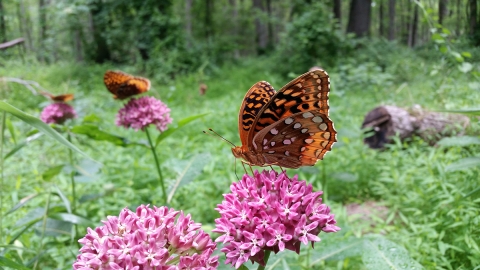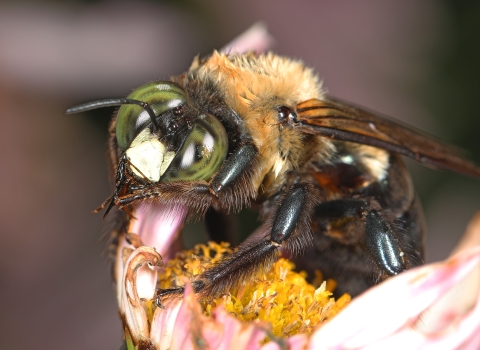Planting milkweed is a one of the many ways you can help the monarch butterfly. Milkweed is the sole host plant to the monarch butterfly's caterpillar, but keeping milkweed as part of our landscape is important to more than just monarch butterflies. Here some species that also use milkweed in various ways.
What Feeds on Milkweed Nectar?
Bees:
- Bumblebees (Bombus spp.) - these are one of the few native social bees, although their colonies are much smaller than those of the non-native honeybee; and only the queen overwinters.
- Carpenter bees - Carpenter bees resemble bumble bees, but the upper surface of their abdomen is bare and shiny black
- Yellow-faced bees, Hylaeus sp.
- Plasterer bees, Colletes sp.
- Sweat or Halictid (family name) bees – these are often bright metallic colors (e.g., iridescent green)
- Leaf-cutting bees (Family name: Megachildae) – so called because they cut pieces of leaves to use in their nests
Moths:
- White-lined sphinx moth (Hyles lineata) – they hover while collecting nectar
- Milkweed tiger or tussock moth (Euchaetias egle); their young also eat the leaves of milkweed plants
Butterflies:
- Eastern tiger swallowtail ( Pterourus glaucus)
- Pipevine swallowtail (Battus philenor
- Red Admiral (Vanessa atalanta)
- Great spangled fritillary (Speyeria cybele)
- American copper (Lycaena phloeas american)
- Edward’s hairstreak (Satyrium edwardsii)
Skippers:
Delaware skipper (Atrytone delaware)
Flies:
Syrphid or hover flies – they often look like bees or wasps and feed on the nectar.
Beetles:
Long-horned beetles in the genus Typocerus - these beetles have long antennae and an elongate body.
Feasting on Milkweed:
In addition to feeding on nectar, the brightly colored large milkweed bug, Oncopeltus fasciatus eats milkweed plant parts, including the seeds.
Young of the Queen butterfly, Danaus gilippus, which is closely related to the monarch, also eat milkweed plant parts.
Finally, you even find predatory insects, like assassin bugs (Zelus sp.), can be found looking for their next meal on milkweed plants.
Marvelous Milkweed
As you can see, milkweed species serve as an important food source for a number of different animals. Plus, by letting milkweed grow, we can welcome these insects to the neighborhood. What insects do you see on your milkweed?
This story is from our Open Spaces blog.





